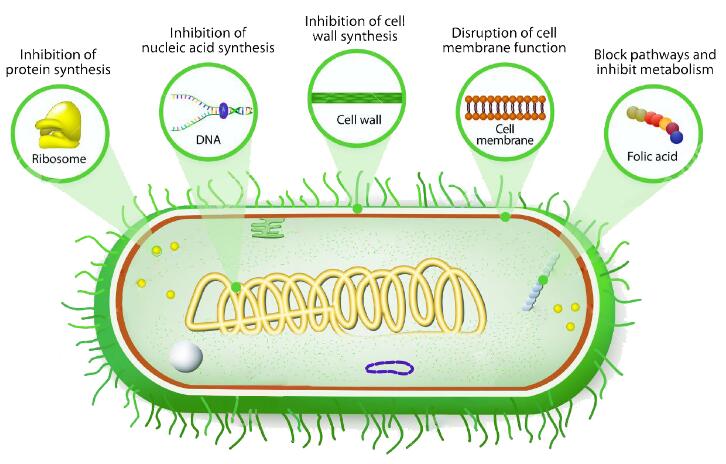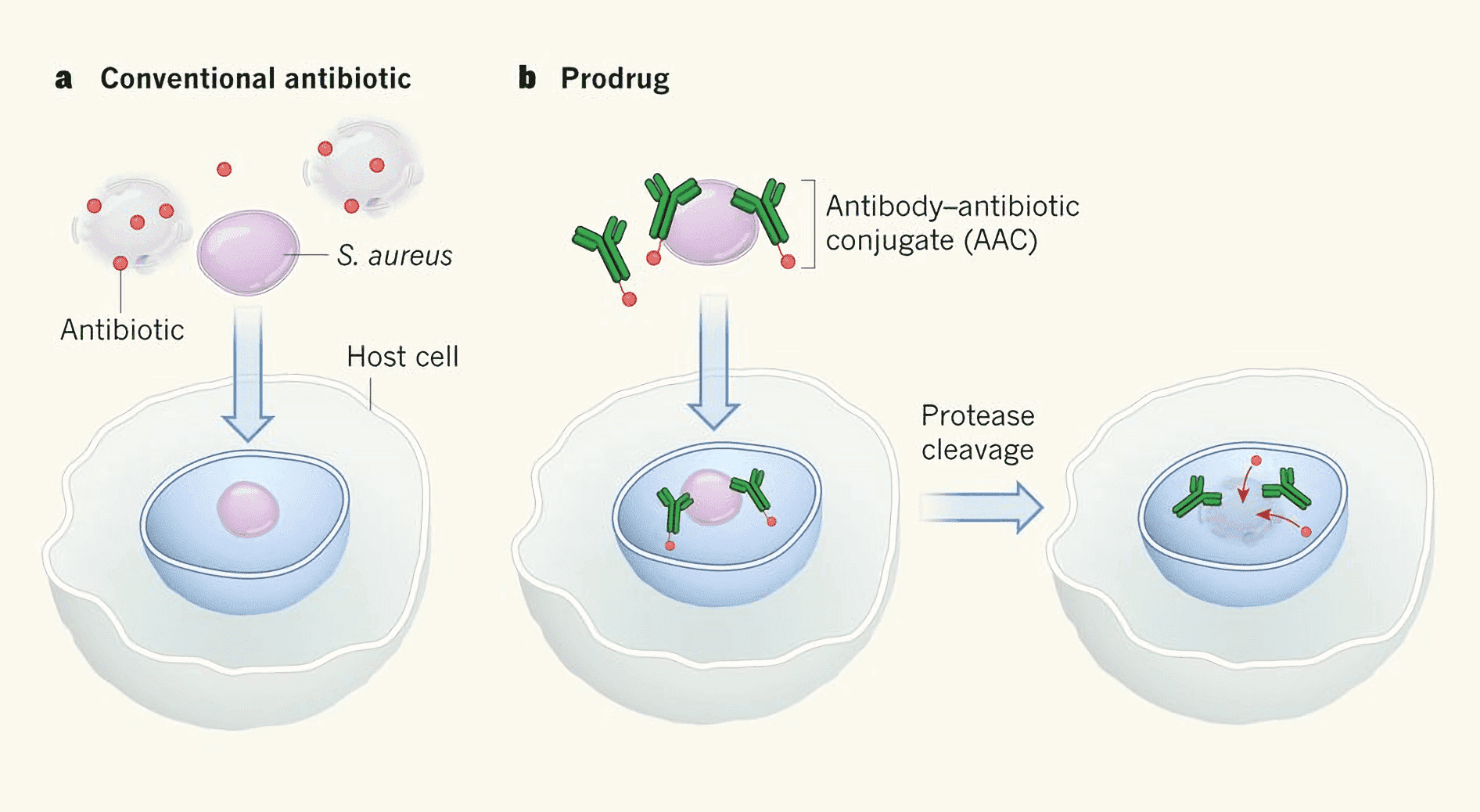- Home
- Services
- Antibody-antibiotic Conjugate (AAC)
- Antibiotic Synthesis
Antibiotic Synthesis
Based on the elaborate chemical synthesis platform and experienced chemical experts, Creative Biolabs provides comprehensive customized antibody-antibiotic conjugates (AACs) development services by using a range of antibiotics as payloads for targeted immunotherapy.
Antibiotic
Antibiotic also referred as antibacterial, is a type of antimicrobial drug used in the treatment and prevention of bacterial infections. They have the ability to kill bacteria or inhibit the growth of bacteria. Some antibiotics also harbor antiprotozoal activity. Medicine was revolutionized by antibiotics in the 20th century. However, the feature of being quite effective and easy to obtain lead to overuse and prompted bacterial resistance to all kinds of antibiotics, which has also caused widespread health problems, such as prolonged illnesses and more deaths. World Health Organization classify antimicrobial resistance as a "serious threat is no longer a prediction for the future, it is happening right now in every region of the world and has the potential to affect anyone, of any age, in any country”. In addition, the number of novel antibiotics or therapeutic modalities under development are not enough to replace older and increasingly ineffective therapies. Therefore, it is urgent to explore available methods and drugs with potent bactericidal activity but does not deteriorate bacterial resistance. Thus, a novel therapeutic modality with the potential to treat bacterial infections has emerged that consists of an AAC, which combines the key attributes of both antibody and antibiotic in a single molecule.
Classification of Antibiotics
Antibiotics are generally classified based on their chemical structure, mechanism of action, or spectrum of activity. Most of the antibiotics target bacterial growth processes or functions. In detail, penicillins and cephalosporins target the bacterial cell wall, polymyxins aims at the cell membrane. Rifamycins, lipiarmycins, quinolones, and sulfonamides interfere with critical enzymes of bacteria. Macrolides, lincosamides, and tetracyclines always inhibit protein synthesis as inhibitors and bacteriostatic (with the exception of bactericidal aminoglycosides). Further categorization is based on their target specificity. Narrow-spectrum antibiotics target particular types of bacteria (Gram-negative or Gram-positive), whereas broad-spectrum antibiotics affect a majority of bacteria. Currently, four new classes of antibiotics have been brought into clinical use: cyclic lipopeptides (such as daptomycin), glycylcyclines (such as tigecycline), oxazolidinones (such as linezolid), and lipiarmycins (such as fidaxomicin).
Mode of Action of Antibiotic
- β-lactam antibiotics inhibit the cell wall synthesis of bacterial, causing the bacteria to collapse and die in the low osmotic pressure environment.
- Polymyxin and gramicidin antibiotics kill bacteria by interacting with the bacterial cell membrane to enhance the permeability of bacterial cell membrane, open the ion channel on the membrane and cause the leak of essential substances of bacteria or the imbalance of electrolyte.
- Tetracyclines, macrolides, aminoglycosides, and chloramphenicol antibiotics with sterilization function by interacting with the bacterial ribosome or its reaction substrate (such as tRNA, mRNA) to inhibit the synthesis of bacterial proteins including these structural proteins and enzymes necessary for cell survival.
- Quinolones antibiotics such as ofloxacin inhibit the replication and transcription of bacterial deoxyribonucleic acid, will lead to the inhibition of bacterial cell division and reproduction and hindering the transcription of DNA into mRNA, which leads to the hindrance of subsequent mRNA translated synthetic proteins.
 Fig.1 The mechanisms of antibiotics action.
Fig.1 The mechanisms of antibiotics action.
Antibiotic-based AACs
AACs using antibiotic as payloads are under active development and evaluation. The specific targeting capability of a monoclonal antibody enables the delivery of antibiotic exclusively to the infection site, thereby reducing collateral damage to the normal tissues. For example, β-GlcNAc-WTA mAb is a distinctive humanized monoclonal antibody, targeting β-GlcNAc residues and it can be a potential antibody candidate for AAC development. β-GlcNAc residues are on the ribitol phosphate units of wall teichoic acid of bacteria. Upon β-GlcNAc binding, β-GlcNAc-WTA mAb-based AAC can be internalized via receptor-mediated endocytosis and the dmDNA31 payload is released to accomplish its cytotoxic effects.
 Fig. 2 Targeted intracellular antibiotic release. Staphylococcus aureus infections are notoriously difficult to treat because the bacteria enter host cells and ‘hide’ in intracellular compartments that conventional antibiotics cannot reach or where they are inactive. b, Antibiotic covalently linked to an antibody that binds to components of the S. aureus cell wall. This prodrug coats the bacterial cell surface but remains inactive until the bacteria enter the host cell. There, protease enzymes cleave the linker region, releasing the active antibiotic, which then kills the bacteria. (Hardt, 2015)
Fig. 2 Targeted intracellular antibiotic release. Staphylococcus aureus infections are notoriously difficult to treat because the bacteria enter host cells and ‘hide’ in intracellular compartments that conventional antibiotics cannot reach or where they are inactive. b, Antibiotic covalently linked to an antibody that binds to components of the S. aureus cell wall. This prodrug coats the bacterial cell surface but remains inactive until the bacteria enter the host cell. There, protease enzymes cleave the linker region, releasing the active antibiotic, which then kills the bacteria. (Hardt, 2015)
With our well-established “DrugLnk” organic synthesis platform, the experienced scientists from Creative Biolabs are dedicated to helping you develop antibiotics-linker complexes using readily available or customized linkers for antibody conjugation in a timely and cost-effective manner. Our customarily tailored services and high-quality products will contribute greatly to the success of your projects. Please feel free to contact us for more information and a detailed quote.
Reference:
- Hardt, Wolf-Dietrich. (2015) "Antibiotics: Homed to the hideout." Nature, 527(7578), 309.
For Research Use Only. NOT FOR CLINICAL USE.

Online Inquiry
Welcome! For price inquiries, please feel free to contact us through the form on the left side. We will get back to you as soon as possible.
